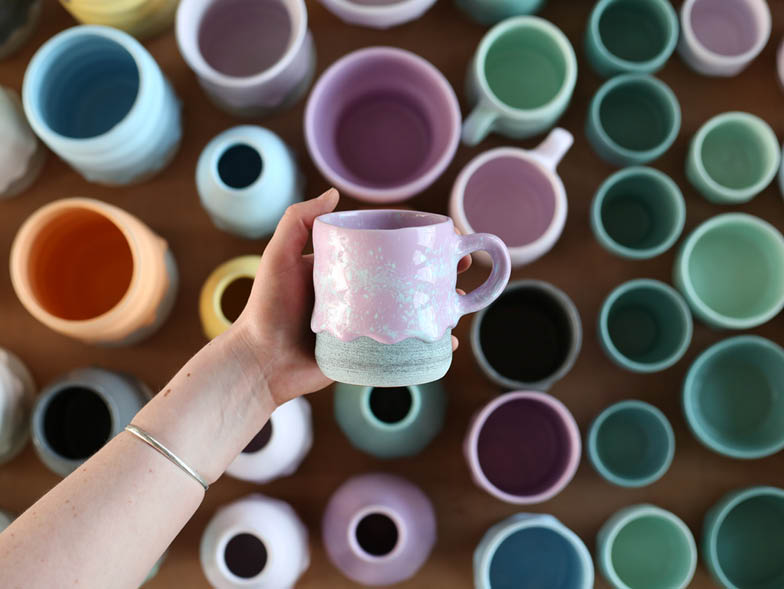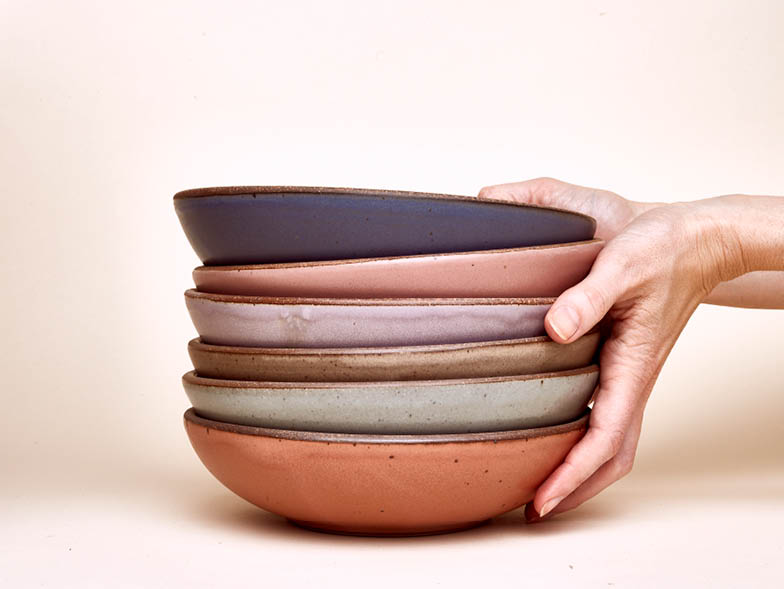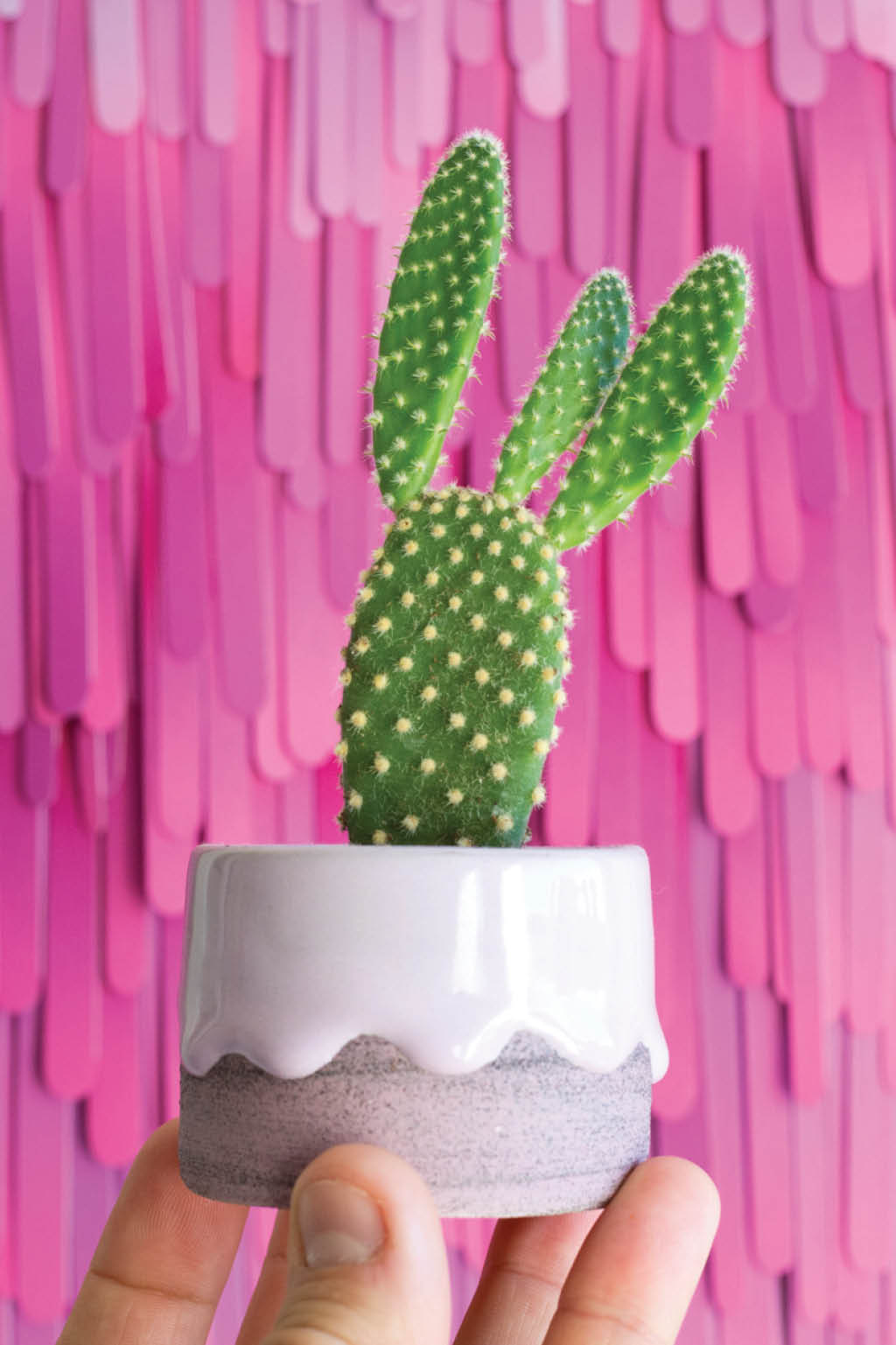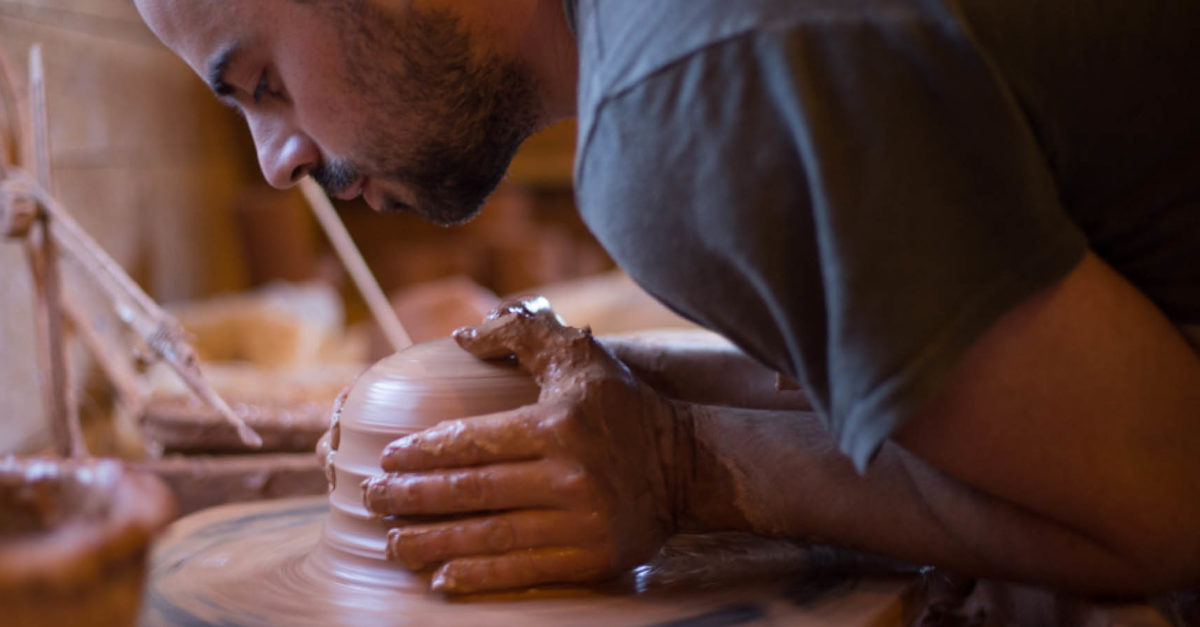Fired Up About Ceramics
Three ceramics experts from different parts of the country share their philosophies on glaze colors, mindfulness, and the endless debate about what it means to be living the dream.

Brian Giniewski of Brian Giniewski Ceramics
How did you arrive at this place in your story?
After finishing graduate school at the Cranbrook Academy of Art in 2009, I took the academic route and moved through a bunch of one-year teaching positions at different universities in an attempt to find the holy grail of a tenure-track position. I was trying to make heady, conceptual art to bolster my academic portfolio, but it had zero commercial value. In 2013, I made my first batch of pastel drippy pots. It was the first time in my life that something I made actually had some sort of resonance or response from a broad audience. It took me about three and a half years of making them in very small batches on evenings and weekends before I decided to quit my full-time teaching job and open up my own business making pots.
Is there anything you miss about teaching?
Yes, absolutely. I love teaching, and I love being surrounded by creative people with an eagerness to learn. Now that I am producing work at a higher volume, I have really been trying to set up my studio as an incubator of sorts. I employ a number of young artists full time to help me, and I try to design their positions as the exact job I would have wanted when I was in their situation.
What is your philosophy of pottery? How does that align with your life philosophy?
I believe that people just generally want to feel happy and content and to be able to express themselves in a way that shows others their true character. I want my pots to make people happy first and foremost, and if they also learn a thing or two about the value of handmade objects and the amount of work, failure, and resilience that this practice entails, then that’s a bonus!
How would you define your style, and how did it develop?
I like to think that I am referencing industrial design in my work but doing it in a way that allows for accidents and discovery. The glaze recipes that I use are all of my own making, and we mix them all in-house. During the hottest point of the kiln firing, the thick glaze literally turns into molten glass and oozes down the piece. I fire them in a computer-controlled kiln, which I’ve programmed to turn off at just the right time to freeze those gooey drips in place. My goal in developing my current glaze palette was to make a material that had the same sense of “deliciousness” as the wet, viscous paint from those pieces.
Where is your studio located? How does the city influence you and your work?
My studio is now the top floor of the Globe Dye Works building in Northeast Philadelphia. This building was a huge factory that dyed yarns for Philadelphia’s once vibrant textile industry, and now a bunch of young creative entrepreneurs have filled the space back up with our own small-batch manufacturing. I take a great deal of pride in knowing that all of my work is made here in Philadelphia, and that this resurgence of making and manufacturing is being noticed around the country and around the world.
Where is your mind when you are creating pottery?
In the best of moments, my mind is nowhere else but right there. The process of focusing so intensely on a hands-on task like pottery can be incredibly helpful, especially for people with anxiety, which is something I have struggled with for a long time. I think that’s the dream for most makers: everything else dissolves away from your periphery, and, for that moment, it’s just you and your work.

Connie Matisse of East Fork
How did the team of East Fork come together?
In 2009, Alex Matisse, a floppy-haired boy from New England, finished an apprenticeship in the North Carolina Piedmont and set out on his own to make pottery on a gloomy old tobacco farm in Madison County, North Carolina. The workshop was tucked away in the mountains, right off East Fork Road. Meanwhile, I was milking goats eight miles away, deep in an existential crisis. We met at the farmers’ market where I was selling cheese, and a few weeks later, I moved in with Tom Waits’s “Come on Up to the House” loud on the stereo. In 2013, our friend John Vigeland came to stay for the weekend. We all drank a lot of wine, read a lot of poetry, and sat by the fire, and before John headed home, he said, “I’d really like to figure out how to work together.”
How did the company evolve into what it is now?
Alex and John were trained in traditional ceramic apprenticeships under North Carolina potters Matt Jones, Mark Hewitt, and Daniel Johnston. When they left the workshops of their teachers and started out on their own, they, like many other potters who learn through apprenticeship, made pots that very much resembled their teachers’ pots. When I came along, with my Los Angeles roots and restaurant background, we began shifting our focus toward functional dinnerware.
What is the shop’s design philosophy?
We make functional, timeless ceramic dinnerware and other useful objects. We believe that eating and drinking are sacred acts and that the objects we use day in and day out for making coffee, serving meals, and pouring water should be beautiful to look at and a pleasure to use.
How many members are creating pottery? How do you create consistency of forms with multiple makers?
Since East Fork was founded in 2010, we’ve grown from a team of two potters to fourteen potters. Trained through formal ceramic apprenticeships, Alex’s and John’s hands have spent thousands of hours in the clay, making hundreds of the same form at a time and building an intimate, familiar relationship between makers and materials. We’ve taken those finely tuned forms and translated them into our new production methods.
How did you arrive at your color palette? Who named the glaze colors?
With my guidance as creative director, we create seasonally inspired glazes rarely found in traditional stoneware. Our glaze chemist, Kyle Crowder, spends four to six months developing each matte glaze, testing for a myriad of variables, from color accuracy to density. Our core mix of neutral-toned glaze provides a foundation for our collection, while the seasonal glazes let our personal style shine a little. Everything is designed to be mixed and matched. We find color inspiration in anything, from fashion to produce to farmers’ market bouquets.
What does it mean to you to “live the dream”?
Our motivation starts from making objects that we see a need for and use in our own homes. Our storefront sells our dinnerware alongside other beautiful, useful objects made by friends and strangers near and far. We host dinner parties, cooking classes, and trunk shows. We raise funds and awareness for people and organizations working to make our communities more equitable and just. It’s a wild world out there, but a tender, beautiful one, too, made ever more sacred by our daily rituals of eating, drinking, and coming together around the table.

Pawena Thimaporn of Pawena Studio
How did growing up in Thailand influence your design aesthetic?
During my early years, I spent most of my time outside of Bangkok. The open space and the natural landscape of the abundant plant life are reflected in the simplicity of my work. I later moved to Bangkok—a city full of busy streets and colorful palettes—for higher education.
My work is a mix of both worlds. Sometimes I make very simple pieces that focus on shape and form, with only small textural decorations, and sometimes I make more colorful works.
What is your educational background? How did your story evolve into a pottery studio?
I attended KMITL’s university in Bangkok for industrial design, with an emphasis in ceramics and textiles. While at the university, I also learned about packaging and graphic design, which led me to continue my studies in those areas. I was curious about the world outside my own country, so I came to the United States to study graphic design at the ArtCenter College of Design in Pasadena, California, and I worked in the design field for fifteen years. In 2015, the design studio I had been working for closed up shop. I had always wanted to start something on my own and have a flexible schedule to spend more time with my kids, so it seemed like a good time to make that change.
How does your background in design inform what kind of pottery you create?
It is ingrained in me to create something that is functional. Ceramics is a perfect fit for this because it gives me the freedom to come up with any design I want to make but also allows me to create functional objects.
Do you have a design philosophy? Does it align with a life philosophy?
I don’t like to be too strict in terms of what and how I will design and what I make. I like to go with the flow. One day, I might want to make just cups and mugs; another day, I might want to experiment with lighting, create a bigger-scale piece, or play with colors. Overall, I want to feel excited about what I make. Sometimes I take on a project just because it is interesting and allows me to have creative freedom. In contrast, my life is very simple.
How did you conceptualize your color palette? What does it say about you?
I like muted colors more than bright colors and matte finish over gloss. But I like to add accents of bright colors or gloss surfaces into the mix with muted colors and matte surfaces. It is like finding the right balance in life—not too boring but not too loud.
Do you have a favorite part of the process?
Throwing on the wheel and painting—I love the feeling of my hand shaping up the clay and how the brush feels pushing against the clay surface.
What is happening in your mind when you are creating pottery?
Working by hand is the best opportunity for me to practice mindfulness. I try not to think about anything, and I only focus on what I am doing at that moment. It’s like one of my favorite teachings: we should move our body more and move our thoughts less.
Do you think the vibe of the city you live in is reflected in your work?
Los Angeles is a very rich, colorful place, with a mix of different cultures from all over the world. The culture can be different from one street corner to the next. I am sure this influences my work in many ways—from the pattern I saw on packaging in a Korean market to the Mexican textiles I found at a weekend fair to the decorations in an Indian restaurant I went to for dinner.
How do your various creative talents fit together?
Since the beginning of my career, I have thought that I should follow my heart and do pottery full time. But if I hadn’t taken the scenic route to get there, earning experience in visual design and photography first, my work wouldn’t be the same as it is now. I didn’t realize until I started my own studio that all of these skills happen to complement each other nicely. I am glad I have the background and skills to put it all together now.
For more info visit:
brianginiewski.com
eastforkpottery.com
pawenastudio.com























